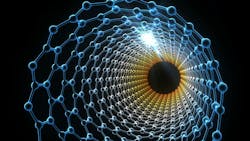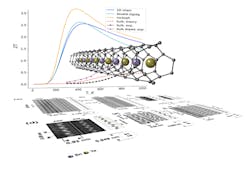Atomically Thin Nanowires Convert Heat to Electricity
Researchers at the University of Warwick found that waste heat can be converted to electricity more efficiently using one-dimensional nanoscale materials as thin as an atom. The discovery ushers in a new way of generating sustainable energy.
Led by Drs. Andrij Vasylenko, Samuel Marks, Jeremy Sloan, and David Quigley from Warwick’s Department of Physics, in collaboration with the Universities of Cambridge and Birmingham, the researchers have found that the most effective thermoelectric materials can be realized by shaping them into the thinnest possible nanowires.
Thermoelectric materials harvest waste heat and convert it into electricity. They are much sought-after as renewable and environmentally friendly sources of energy.
Dr Andrij Vasylenko, from the University of Warwick’s Department of Physics and the paper’s first author, commented, “In contrast to three-dimensional material, isolated nanowires conduct less heat and more electricity at the same time. These unique properties yield unprecedented efficiency of heat-to-electricity conversion in one-dimensional materials.”
The diagram shows one-dimensional nanowires converting waste heat to electricity. (Source: University of Warwick)
The researchers, which included the group led by Dr. Andrew J. Morris from the University of Birmingham, were investigating the crystallization of tin telluride in extremely narrow carbon nanotubes used as templates for the formation of these materials in their lowest dimensional form.
In a combined theoretical-experimental research, they were able to establish a direct dependence between the size of a template and a resulting structure of a nanowire. In addition, they demonstrated how this technique can be used for regulation of the thermoelectric efficiency of tin telluride formed into nanowires that are 1-2 atoms in diameter.
First author Dr Vasylenko is excited about where this research could lead. “This opens up an opportunity for creation of a new generation of thermoelectric generators, but also for exploration of alternative candidate materials for thermoelectrics among abundant and non-toxic chemical elements.”
With a growing demand for both miniaturization and enhanced efficiency of thermoelectrics, nanostructuring offers a viable route for targeting both objectives.
Their results are reported in the journal ACS Nano; the research paper is entitled “Electronic Structure Control of Sub-nanometer 1D SnTe via Nanostructuring within Single-Walled Carbon Nanotubes.”
The computational research was conducted on the ARCHER Supercomputer, funded by EPSRC. Experimental imaging was performed in Warwick as well as at STFC SuperSTEM, which is also supported by the EPSRC.
About the Author

Sam Davis
Sam Davis was the editor-in-chief of Power Electronics Technology magazine and website that is now part of Electronic Design. He has 18 years experience in electronic engineering design and management, six years in public relations and 25 years as a trade press editor. He holds a BSEE from Case-Western Reserve University, and did graduate work at the same school and UCLA. Sam was the editor for PCIM, the predecessor to Power Electronics Technology, from 1984 to 2004. His engineering experience includes circuit and system design for Litton Systems, Bunker-Ramo, Rocketdyne, and Clevite Corporation.. Design tasks included analog circuits, display systems, power supplies, underwater ordnance systems, and test systems. He also served as a program manager for a Litton Systems Navy program.
Sam is the author of Computer Data Displays, a book published by Prentice-Hall in the U.S. and Japan in 1969. He is also a recipient of the Jesse Neal Award for trade press editorial excellence, and has one patent for naval ship construction that simplifies electronic system integration.
You can also check out his Power Electronics blog.


